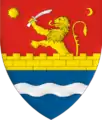Otelec
Ótelek | |
|---|---|
 Location in Timiș County | |
 Otelec Location in Romania | |
| Coordinates: 45°37′N 20°51′E / 45.617°N 20.850°E | |
| Country | Romania |
| County | Timiș |
| Government | |
| • Mayor (2020–2024) | Simona-Silvia Fechete[1] (PRO) |
| Area | 83.14 km2 (32.10 sq mi) |
| Population (2021-12-01)[3] | 1,657 |
| • Density | 20/km2 (52/sq mi) |
| Time zone | EET/EEST (UTC+2/+3) |
| Postal code | 307446–307447 |
| Vehicle reg. | TM |
| Website | www |
Otelec (known as Ungureni in the interwar period; Hungarian: Ótelek) is a commune in Timiș County, Romania. Established in 1856, it was abolished in 1968 and absorbed into Uivar. It was recreated in 2008.[4] It is composed of two villages, Iohanisfeld and Otelec (commune seat).
History

Otelec was first mentioned in 1452 as Feltelek, when it belonged to Keve County.[5] During the Ottoman period (16th–17th centuries) the locality was depopulated, and the uncultivated lands were transformed into swamps.[6] It was not until 1793–1795, under the Habsburgs, that the settlement was re-established with families of colonists, mostly Hungarians, brought by Count Johann von Buttler from the southern counties of the empire.[6] From 1856 it became an independent commune. At the same time, the first state school was opened (extended in 1885) and the construction of the Roman Catholic church was completed.
Iohanisfeld was founded by German (Banat Swabian) settlers in 1805, about 90 years after the beginning of the colonization of Banat. They came mostly from neighboring localities, such as Jimbolia, Lenauheim or other Swabian communes, on the estates of Count Johann von Buttler with whom they concluded leases. In honor of the tenant Johann, German peasants called the locality Johannisfeld ("John's field").[7] The colonists settled here quickly and, only two years after the construction of the first houses, they started the construction of the first school. Later, the colony became the property of the state, and the inhabitants were able, between 1865–1875, to buy back their properties from it. The Roman Catholic church was built in 1833.
Both Otelec and Iohanisfeld were severely affected by the floods of April–May 2005, with most of the built-up areas being covered for months by the overflowing waters of the Timiș River.[8] About two-thirds of the households were totally or partially destroyed. The houses were rebuilt following the reconstruction program coordinated and financed by the Romanian Government.[9] Also, during 2006, from budgetary funds and from aid from the country or abroad, most of the public buildings (kindergarten, school, dispensary, community center, etc.) were rehabilitated or rebuilt.
Demographics
Otelec had a population of 1,499 inhabitants at the 2011 census, down 12% from the 2002 census. Most inhabitants are Romanians (57.24%), with a minority of Hungarians (37.83%). For 3.8% of the population, ethnicity is unknown.[10] By religion, most inhabitants are Orthodox (50.37%), but there are also minorities of Roman Catholics (38.09%), Pentecostals (3.67%), Reformed (1.47%) and Jehovah's Witnesses (1.27%). For 3.94% of the population, religious affiliation is unknown.[11]
| Census[12] | Ethnic composition | ||||
|---|---|---|---|---|---|
| Year | Population | Romanians | Hungarians | Germans | Serbs |
| 1880 | 2,745 | – | 965 | 1,756 | 19 |
| 1890 | 3,434 | 7 | 1,524 | 1,881 | 19 |
| 1900 | 3,528 | – | 1,644 | 1,843 | 26 |
| 1910 | 3,631 | 18 | 1,969 | 1,605 | 34 |
| 1920 | 3,550 | 17 | 1,893 | 1,607 | – |
| 1930 | 3,461 | 54 | 1,699 | 1,677 | 22 |
| 1941 | 3,377 | 129 | 1,543 | 1,643 | – |
| 1956 | 3,343 | – | – | – | – |
| 1966 | 2,786 | 327 | 1,395 | 1,048 | 7 |
| 1977 | 2,257 | 444 | 1,168 | 640 | 2 |
| 1992 | 1,637 | 825 | 765 | 43 | 4 |
| 2002 | 1,705 | 994 | 688 | 18 | 1 |
| 2011 | 1,499 | 858 | 567 | 12 | 3 |
References
- ↑ "Results of the 2020 local elections". Central Electoral Bureau. Retrieved 16 June 2021.
- ↑ "Primăria Otelec". Ghidul Primăriilor.
- ↑ "Populaţia rezidentă după grupa de vârstă, pe județe și municipii, orașe, comune, la 1 decembrie 2021" (XLS). National Institute of Statistics.
- ↑ "Lege nr. 108 din 9 mai 2008 privind înființarea comunei Otelec, prin reorganizarea comunei Uivar, județul Timiș". Portal Legislativ.
- ↑ Szabó, M. Attila (2003). Erdély, Bánság és Partium történeti és közigazgatási helységnévtára. Miercurea Ciuc: Pro-Print Kiadó.
- 1 2 "Fișa Primăriei comunei Otelec". Consiliul Județean Timiș.
- ↑ Crețan, Remus (2006). Dicționar toponimic și geografico-istoric al localităților din județul Timiș. Timișoara: Editura Universității de Vest. p. 152. ISBN 973-7608-65-8.
- ↑ Mihuț Codea, Daniel (2013). "Timiș River Flooding in Banat (Romania) in 2005". Transylvanian Review of Systematical and Ecological Research. 15 (3): 13–22. doi:10.2478/trser-2013-0029.
- ↑ Calabalîc, Petrina; Ardelean, Horațiu (4 May 2005). "Peste 3.500 de bănățeni, sinistrați în urma inundațiilor, și-au petrecut sărbătorile în pribegie". Bănățeanul.
- 1 2 "Tab8. Populația stabilă după etnie – județe, municipii, orașe, comune". Institutul Național de Statistică.
- 1 2 "Tab13. Populația stabilă după religie – județe, municipii, orașe, comune". Institutul Național de Statistică.
- ↑ Varga, E. Árpád. "Temes megye településeinek etnikai (anyanyelvi/nemzetiségi) adatai 1880-2002" (PDF).
